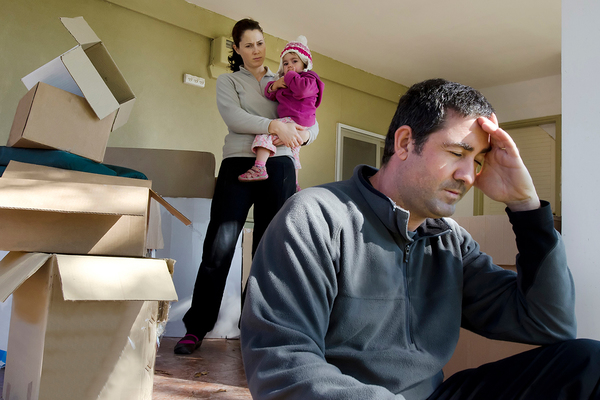You are viewing 1 of your 1 free articles
LHA cap: a sinking feeling
The LHA cap is set to leave Welsh landlords and tenants in a sticky situation. Jules Birch investigates what is likely to happen as a result
Across Wales, social landlords could be forgiven for preparing for the Local Housing Allowance (LHA) cap with a sense of weary resignation.
It is one more welfare reform to add to the bedroom tax, the overall benefit cap and all the others seen since 2010 – and there is Universal Credit to contend with before the LHA cap affects tenants in general needs housing in 2019.
But as landlords digest the implications of first the cap and then the decision to apply it to existing tenants on Universal Credit, there is a sense that this is different.
The effect of the cap will vary according to rent levels, LHA rates and stock profiles around the country. In Broad Rental Market Areas (BRMAs) for cities such as Cardiff, Swansea and Newport, LHA rates are above current social rent levels.
However, in deprived areas, such as the Valleys, LHA rates are significantly lower than rents. That means not just the shared accommodation rate for the under-35s, but also one, two and even three-bed homes in some places.
Built-in distortions
“There are real questions of inequity and inequality,” says Michelle Reid, chief executive of Cynon Taf Community Housing. “Yet again, it’s the poorest people paying for the poorest policies.” The effects will be amplified by the way the LHA operates. Rates are frozen until 2019/20 regardless of what happens to rent levels. If that does not concentrate the mind enough, rates cannot rise but they can still fall – and once they do they cannot go up again.
“There are real questions of inequity and inequality.”
Michelle Reid, chief executive, Cynon Taf Community Housing
There are also distortions built into the system, especially in rural areas and small towns where there are very few shared and one-bed flats in the private rented sector, but their rents determine LHA rates. In Merthyr Tydfil, Mike Owen, chief executive of Merthyr Valleys Homes, says: “Perhaps as few as four private rented properties of very poor quality are setting the LHA threshold for more than 500 one-bed properties that we own.”
Attention has understandably focused on the under-35s but there will also be an effect on the over-65s. Pensioners are exempt from the bedroom tax but not from the LHA cap.
“It’s almost like a bedroom tax being applied for that group,” says Paul Langley, head of business development in the Your Benefits are Changing team at Community Housing Cymru.
In facing up to all this, there are some important differences between Wales and England.
Control over rent policy is devolved and Wales still has an inflation-plus-rent formula. This may give some landlords extra flexibility but for others it will mean even bigger shortfalls against LHA rates. Westminster is in effect reasserting control over rents via the LHA cap.
The Welsh Government supports and still funds social housing and has working parties looking at housing for the 18 to 21s and under-35s.
Wales also has a housing sector that is determined to maintain its community focus and close co-operation between housing associations and local authorities. “The commitment is still there that where there is need it will be met, especially with the homelessness legislation in Wales,” says Mr Langley.
Inside Housing spoke to six different social landlords in different parts of Wales to assess the impact of the LHA cap. The policy is forcing some hard thinking on virtually everything they do. Rents policy, service charges, allocations, affordability tests, design and development, asset management, financial inclusion, support into work – you name it and somebody somewhere is thinking through the implications for their organisation.
“The big issue for us is: why should tenants with some of the lowest rents in Great Britain have to make some of the biggest contributions?”
Mike Owen, chief executive, Merthyr Valleys Homes
Merthyr Valleys Homes faces LHA rates that are among the lowest in Wales. The shared accommodation rate is just £48 a week and one-bed LHA is £67.76 against its one-bed target rent of £79.
“The big issue for us is: why should tenants with some of the lowest rents in Great Britain have to make some of the biggest contributions?” says Mr Owen. “A tenant living in Cardiff will pay no rent contribution and in Theresa May’s constituency there is a significant gap between social rents and LHA.”
READ MORE ABOUT SUPPORTED HOUSING FUNDING:

The supported housing funding merry-go-round
Manchester providers offer to pilot alternative to LHA cap
Civil servant quizzed over supported housing funding rationale
Housing leaders: fix for social care requires supported housing certainty
Merthyr Valleys Homes is currently reviewing its rent policy in response to the cap. “We will probably look at some of the properties that are let to under-35s and lowering the rents to LHA,” Mr Owen says.
“We may move some rents down to LHA and increase others. This will all be part of a big debate with our tenants over the next nine months.
“We’ll look at what someone can afford, whether they are working, working part-time or on benefit – then try to balance the rent so it’s fair to all three, but looking at the living rent threshold of affordability of around 28% of income.”
Stark implications
Neighbouring Cynon Taf Community Housing has the same problem with low LHA rates. Its average rent for a one-bed flat is just £70 a week but that is still more than both the £48 a week shared accommodation rate and the one-bed LHA rate. Of its 1,850 properties, between 400 and 450 are more than LHA rates just on rent and some have service charges on top.
The implications for new development are stark, says Ms Reid. “For us to build a one-bed flat, charge £48 a week and make it stack up, we would have to build it for £17,000, including the price of the land,” she says.
Cynon Taf is looking at innovative ways of developing, for example by designing out service charges or letting commercial units below flats. However, using containers could be the only way to develop schemes for the under-35s within LHA rates.
“For us, this is our number one risk, and both our board and staff are fully engaged in managing the impact,” she says. “We are stress testing, looking at community development solutions, resilience profiling, how we can soften the impact and new ways of developing for young people. Realistically we’ve got about a year to really implement solutions.”
“Whatever we do around sharing or different methods of construction, the important thing is that it’s somewhere that people want to live.”
Stephen Evans, director of housing, Charter
Charter Housing, part of Pobl Group, has 4,200 homes across South Wales and estimates the cap will affect more than 500 households.
“There isn’t going to be one thing that will make a difference but a series of things that we want to trial,” says Stephen Evans, director of housing at Charter.
In Newport, Charter is working on a pilot project on sharing with the council and homelessness charity Llamau, and is thinking about compatibility as well as need. In Caerphilly, it is considering developing new two-bed flats each with en suite bathrooms and rooms of equal size.
“We’re working with people on the waiting list to change their expectations about sharing as most don’t expect to have to share,” Mr Evans explains. “But whatever we do around sharing or different methods of construction, the important thing is that it’s somewhere that people want to live.”
Newydd Housing Association estimates that 22% of its properties are above LHA rates on rent level alone, rising to 44% when service charges are included. However, the impact varies across different areas.
“Our geographical spread gives us more options but we don’t want the LHA to become our rent-setting policy because we don’t think it’s a very good one,” says Elizabeth Lendering, finance and resources director at Newydd.
“We don’t want the LHA to become our rent-setting policy because we don’t think it’s a very good one.”
Elizabeth Lendering, finance and resources director, Newydd
Newydd’s rents policy is not settled yet but reducing the rents on smaller properties is one option it is considering. “We have scope in some areas to put up the rents but we really are resisting that. We are trying to take out costs where we can.”
But asset management will also come into play. “Unless it’s an area where we really want to keep non-performing stock we’ll dispose of it and put the money into good stock,” says Ms Lendering.
Newydd is looking to design out service charges where it can, for example by building walk-up flats with no communal areas. With funding from homelessness charity Crisis, it is also working on a pilot project on sharing for the under-35s.
The implications of the LHA cap really hit home in the space of a few days at Cartrefi Cymunedol Gwynedd (CCG), a stock transfer association in North Wales.
In February, it agreed rents for 2017/18 in line with the Welsh Government’s rent formula and its own plans for rent convergence across the county. A week later new LHA rates were announced.
Rethinking rent
In south Gwynedd, the two-bed rate fell 5% to £80.50. One-bed rents are already below LHA rates across the whole county, while CCG estimates that three-bed rents will hit the LHA rate in the south by 2018/19. That’s prompted a rethink.
“At the moment, we are reviewing our rent policy and looking at the whole idea of whether convergence is deliverable,” says Paul McGrady, director of resources at CCG. “We may have to split the county in two. We’re looking at that and expect to go out to tenants in autumn.
“When we were created, our business plan was based on having the same rents across the country so if we keep rents down in the south that will put us under pressure.”
Flintshire County Council has retained its housing stock and has ambitious plans for new development. However, the combination of the LHA cap and Universal Credit – it became the first full-service area in Wales in April – will have major implications.
Clare Budden, chief officer for community and enterprise at the council, says the challenges are different for housing associations that are trying to secure their income base, and local authorities that also have wider responsibilities for homelessness and social services. “If you think the tenant is going to struggle to pay but you also have a statutory duty to house, what do you do?” she says.
“If we operate very efficiently, we should be able to repair and maintain our existing stock but it will hit our new build.”
Clare Budden, chief officer for community and enterprise, Flintshire County Council
“We are also working to reduce evictions and looking at how we can keep people in a property even though they are in debt because we know the costs of eviction and homelessness can be more; never mind the impact on the family. If people can’t fulfil their obligations in a social rented property, what else is available?”
Although Flintshire’s LHA rates are higher than in some parts of Wales, it calculates that the cap will hit its one-bed flats within 12 to 18 months.
“Our business plan assumes current rent policy is maintained,” Ms Budden says. “That extra income enables us to build significant numbers of new properties. If we operate very efficiently, we should be able to repair and maintain our existing stock but it will hit our new build.”
Despite Flintshire’s recent experience with Universal Credit and the problems that will cause, she argues that when it comes to housing as a whole, “the LHA cap is the biggest risk to meeting housing need across the UK because it will hit our ability to build new homes”.
But she also says: “I am an optimist. You hope that Universal Credit will be a significant risk issue for a few years and during that time we’ll start to build some smaller and cheaper properties that people can afford, and people’s expectations of what they can aspire to will need to change.
“You hope we’ll go through a really difficult few years and then things will settle – and we’ll get a change of policy.”












